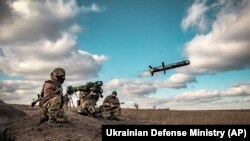On January 25, Russia’s RIA Novosti state news agency published a story quoting a pro-Russian politician in Ukraine who derided the weapons that the United States had sent that country.
Speaking on the pro-Russian TV channel Nash (Ours), Valery Gnatenko, a deputy in the Verkhovna Rada, Ukraine’s parliament, claimed U.S. anti-tank weapons were out of date and inferior to locally-built systems.
“What they delivered to us is, by and large, crap from the ‘80s. In Ukraine, there are even better (than Javelin. — Ed.) Skif anti-tank systems. They are more accurate.”
That is false.
The United States has provided Ukraine with more than $2.7 billion in military aid, counting equipment and training, since the war in the Eastern Donbas began in 2014.
Among other things, the equipment includes night-vision devices, counter-battery radar systems, body armor and .50-caliber sniper rifles. Larger items include armored Humvees and patrol boats. While some of these designs date back to the 1980s, they are still in use today.
The FGM-148 Javelin ATGM (anti-tank guided missile) is a portable system consisting of a Command Launch Unit (CLU) and missile in a container. Two features make the Javelin particularly lethal for tanks.
The first is its method of top-attack: Tank armor is typically thinnest at the top, and the Javelin missile takes advantage of this by flying in an arcing path to strike from above. The second, and arguably more important feature is its infrared-seeking guidance system, which makes the weapon “fire-and-forget.”
This means that after acquiring the target and launching the Javelin, the operator may seek cover and change locations. Most other ATGMs require the operator to maintain the sight on the target to guide the missile all the way. This can leave the ATGM crew vulnerable to being detected or attacked.
The Ukrainian-designed Skif ATGM does out-range the Javelin. Although the Javelin is capable of engaging targets over 4 km away, its maximum effective range is listed at 2,500 meters. By contrast, the Skif’s listed maximum range is 5,000 meters or 5,100 meters, depending on the missile being used.
On the other hand, the Skif is not truly fire-and-forget. Although it has an automatic tracking system for keeping the target in sights until missile impact, it is still guiding the missile via a laser beam. The Skif is also considerably heavier than the Javelin and must be mounted on a tripod.
With more than 100,000 Russian troops massed along Ukraine’s borders, the U.S. and its allies have stepped up deliveries of lethal aid to Ukraine, including more Javelin ATGMs.
Britain has also begun shipping large quantities of the NLAW, another advanced anti-tank weapon. Although it lacks the Javelin’s long range, it is even more portable and works on a similar, albeit less advanced fire-and-forget principle.





